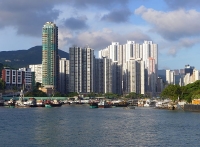
Some 200 years ago, Hong Kong's Aberdeen district was a haven for pirates. Located on the southern shore of Hong Kong Island, it is home to the Tanka boat people and has become a popular tourist destination. Visitors can experience the traditional lifestyle of boat dwellers and sample fresh seafood. Aberdeen is a lively marina crammed with junks, sampans, water taxis (kai do), cruisers and yachts. The fishing harbour is a wonderful way to experience the activity of life on water. Tours along Aberdeen's watery stretches can be enjoyed onboard one of the many sampans offering half-hour trips around the harbour. The sensory delights of Hong Kong cuisine can be sampled within the unique environment of the famous, ornately decorated Jumbo Floating Restaurant.Recently some tourists have complained that this attraction is not as compelling as it once was, partly because the population of people living on the water seems to be decreasing and witnessing this traditional lifestyle was one of the primary draws of the area. If you are a lover of boats and harbours you will no doubt still find much to interest you in Aberdeen, but if you are going solely to experience the authentic living conditions of local fishermen you may be disappointed.
Address : South District, Hong Kong Island
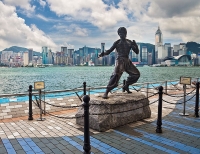
The Avenue of Stars is Hong Kong's version of the Hollywood Walk of Fame, celebrating famous icons of Hong Kong cinema. Situated along the seaside promenade, there are great views of Victoria Harbour. The Avenue is also a good place to view the Symphony of Lights, a music and laser show staged every night at 8pm. The show is presented in English on Mondays, Wednesdays and Fridays; Tuesdays, Thursdays and Saturdays it is in Mandarin; and Sundays in Cantonese. Although the Avenue is a lovely place to stroll and has some interesting landmarks, foreigners should bear in mind that they may not recognise many of the celebrities being honoured on the walk. Still, names like Jackie Chan, Bruce Lee and Jet Li may produce excitement - there's even a statue of Bruce Lee. The real reason for making the effort to visit the Avenue, however, is the spectacular view. It is worth doing the walk at night, even if you don't intend to see the Symphony of Lights show. It's also a good people-watching post and it is fun to watch the locals celebrating their favourite stars.
Address : Along the Tsim Sha Tsui Promenade next to the southern end of Salisbury Garden
Website : www.avenueofstars.com.hk
Admission : Free
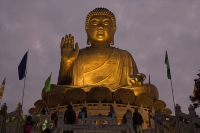
The Big Buddha, or Tian Tan Buddha, is one of the tallest outdoor seated bronze Buddha statues in the world, and can be found near Po Lin Monastery. The giant Buddha is a popular tourist destination and a major centre of Buddhism in Hong Kong. The 112-foot (34m) high statue sits on a lotus throne on top of a three-platform altar and is surrounded by eight smaller statues of gods. Inside the three floors beneath the Buddha visitors can access the Hall of the Universe, the Hall of Benevolent Merit and the Hall of Remembrance. Visitors can also climb the 268 steps to reach the platform where the impressive figure is seated, and admire the view from the top.The Tian Tan Buddha is a lovely excursion from the city and the short trip is a great break from the crowds and noise of Hong Kong. You can take the cable car either one way or both - some people prefer to either hike down through the hills after taking the cable car to the site, or to get there on the ferry and buses before taking the scenic cable car route back down into the city. There are many places to get refreshments at the site with both traditional meals and international fare like Starbucks on offer. Try to visit the Buddha on a clear day, when the views are at their best.
Address : Ngong Ping plateau
Admission : Free. A fee is charged for access to the exhibition halls below.
The Hong Kong Museum of History showcases Hong Kong's archaeological, cultural and natural history through a display of cultural objects, artefacts, photographs, traditional costumes and models that span 6,000 years. Glorious period sets tell the story of Chinese life in replicas of village houses, streets and stores. These memorials to the past are contained within an incredible building opened in 2000. The museum was established much earlier, however, in 1975, and contains artefacts which were originally housed in the City Museum and Art Gallery, which was established in 1962 and became the Hong Kong Museum of Art.The main museum has five interesting branch museums in Hong Kong: the Hong Kong Museum of Coastal Defence at Shau Kei Wan, the Lei Cheng Uk Han Tomb Museum at Sham Shui Po , Law Uk Folk Museum at Chai Wan, Fireboat Alexander Grantham Exhibition Gallery inside the Quarry Bay Park, and Dr Sun Yat-sen Museum at Mid-levels in Central. There is a museum shop selling a selection of souvenirs and replicas, and a cafe for refreshments on the premises.
Address : 100 Chatham Road South, Tsim Sha Tsui, Kawloon (next to the Hong Kong Science Museum)
Website : www.lcsd.gov.hk/hkmh
Telephone : +852 2724 9042
Transport : MTR Tsim Sha Tsiu, then walk via Granville Road; maxicab no 1 from Kowloon Star Ferry in Tsim Sha Tsiu to Science Museum Road
Opening times : Mondays and Wednesday to Friday 10am to 6pm. Saturdays, Sundays and public holidays 10am to 7pm. Closed on Tuesdays.
Admission : Free (some temporary or special exhibitions may cover entry charges)
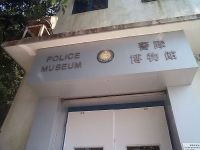
The Hong Kong Police Museum showcases a display tracing the development and history of the Royal Hong Kong Police Force from 1844 to today. The main exhibit encompasses a significant number of artefacts relating to the Hong Kong Police Force from uniforms and firearms, to historical archives and photographs. Other exhibits look at the major factions which have influenced the status quo, namely the triad societies and narcotics (Hong Kong was founded on the narcotics trade), including a unique look at how heroin is produced.The Police Museum is an interesting visit, providing insight into the dedication of the officers who have served within this elite force. It is a small but informative museum with a little gift shop attached. It is not an interactive, multi-media exhibit so much as a simple but interesting archive of police history which will delight those interested in the subject but probably bore small children or those indifferent to the subject. There is a pleasant park next door to the museum where you can enjoy some shade and refreshments.
Address : 27 Coombe Road, The Peak, Hong Kong
Telephone : 2849 7019
Transport : Take NWFB Bus No. 15 (from Exchange Square to the Peak). Get off at the stop between Stubbs Road and Peak Road.
Opening times : Wednesday to Sunday 9am to 5pm; Tuesday 2pm to 5pm. Closed Mondays and public holidays.
Admission : Free

Children on holiday in Hong Kong who want to see crocodiles, butterflies, birds and mangroves should head to the Hong Kong Wetland Park. The Wetland Park showcases the incredible diversity of Hong Kong's wetland ecosystem and the park's main objective is conservation and the education of the public about the importance of preserving this natural system. The park is comprised of a visitor centre, Wetland Interactive World, and a big Wetland Reserve. The Wetland Interactive World has themed galleries and exhibitions, a theatre, a gift shop, and an indoor play area (theme: swamp adventure). Interactive and educational games are a great feature of the centre, as are the sound booths where kids can compose wetland symphonies using the sounds of this fascinating ecosystem. All the games and displays can be absorbing so be sure to actually go outside and enjoy the beautiful walks and the three bird hides, which children will love. The park also hosts some fun events, like bird watching festivals.This attraction is consistently popular with tourists and makes for a really lovely break from Hong Kong's indoor, urban attractions - it'll delight people of all ages interested in nature and animals and will allow kids to blow off some steam outdoors.
Address : Tin Shui Wai, New Territories
Website : www.wetlandpark.gov.hk/en
Opening times : Open daily 10am to 5pm; except Tuesdays, when it is closed.
Admission : HK$30 (adult), HK$15 (child, and other concessions).
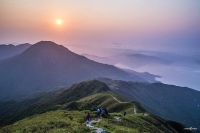
Lantau is the largest of the 235 outlying islands in Hong Kong, being almost twice the size of Hong Kong Island. It is best known for its walking trails and beaches and provides a pleasant respite from crowds and shopping. The main arrival point to the island by ferry is at Mui Wo (Silvermine Bay). The finest beaches are located along the west coast, most notably Cheung Sha. Besides beaches, Western Lantau is the location of the Po Lin Monastery, the largest temple in Hong Kong. Beyond the doorstep of this vast temple is one of the world's largest outdoor Buddha statues. Aptly named Tian Tan Buddha (Big Buddha), the bronze statue sits contemplatively looking over the reaches of Ngong Ping Plateau.From the monastery buses will transport visitors to the quaint fishing village of Tai O. Here little wooden houses perch on stilts and much of life flows from the fishing industry that sustains it. Lantau's north shore is predominantly a farming region. The main attraction here, however, is the historical Tung Chung Fort, which was built in the early 19th century as part of a short-lived attempt to suppress the opium trade and defend the coastal area from pirates. Six old Qing Dynasty cannons dating back to 1832 stand on the ramparts. Development has changed the landscape of the Northeastern stretches of Lantau, known as Discovery Bay. Here upmarket housing complexes, shopping malls, yacht clubs and golf courses promise to provide the ultimate designer lifestyle at a price.
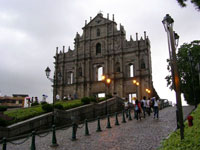
The cultural influence of the Portuguese, combined with traditional Chinese life, has produced a unique landscape in Macau. Here Baroque churches and colonial mansions rise from cobbled pavements interspersed with plazas and cafes. Visitors are enticed here by the lure of gambling, but many of Macau's attractions result from its architectural heritage. St Paul's Cathedral is one such legacy that dates back to the early 17th century. It is an Italian-designed building perched on a hilltop that is most spectacular when illuminated against a night sky. The vantage point from the Fortaleza de Monte is a good place to reflect on the defensive role it played against Dutch assault in 1622, and it is worth exploring the museum and meteorological observatory.The classic Chinese temple of A-Ma rests at the base of Penha Hill. Its name derives from Tin Hau, Queen of Heaven, or the Honoured Mother. Myth has it that a poor girl saved the fishing vessel, on which she was travelling, from the ravages of a storm. In tribute to her this temple was built and has been established as a place of pilgrimage for Macau's fishing community. Another temple dedicated to the power of female intervention is the Kun Iam Temple, built in honour of the Goddess of Mercy, located in the northern reaches of the peninsula. It was here, in 1844, that the first trade and friendship treaty between the USA and China was signed. Macau is 37 miles (60km) west of Hong Kong; ferries take around an hour to get there and leave roughly every fifteen minutes.
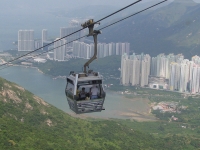
The Ngong Ping 360 Cable Car is a spectacular four-mile (6km) ropeway that affords panoramic views over the bay and surrounding area on its 25-minute journey to the Ngong Ping Village. As visitors approach the cable car terminal on top of the plateau views will include the huge Tian Tan Buddha Statue and the Po Lin Monastery. The Ngong Ping Village is situated right next to the cable car terminal, which features attractions such as 'Walking with Buddha', the 'Monkey's Tale Theatre', and the 'Ngong Ping Teahouse', as well as an assortment of shopping and dining options. Walking with Buddha plunges visitors into a multimedia presentation that follows the life of Siddhartha Gautama (the man who became Buddha) and his path to enlightenment, while the Teahouse provides demonstrations of traditional Chinese tea ceremonies. The Monkey's Tale Theatre presents a charming and comical show inspired by famous Buddhist Jataka stories that will enchant both old and young.The cable car is an incredible experience and there are a variety of packages to choose from. For instance, you can choose between the more expensive Crystal Cabin - which has a transparent floor - and a regular one. Note that queues for this attraction can get very long.
Address : Lantau Island
Website : www.np360.com.hk
Opening times : Monday to Friday 10am to 6pm, Weekends and Public Holidays 9am to 6.30pm.
Admission : There are a variety of ticket options - check the official website listed above for details.
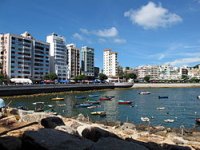
Located just 40 minutes from downtown Hong Kong by bus, the small fishing village of Stanley is a popular day trip for tourists looking to escape the congestion of the city. A bustling village, Stanley is home to a number of attractions and diversions, including several scenic temples and museums.The famous Stanley Market is a winding maze of stalls selling souvenirs like t-shirts, keychains, and knock-off goods, although there's a better selection in Hong Kong City. Bars and restaurants along the waterfront provide good food with great views of the harbour, and the amphitheatre hosts free concerts on the weekends.Stanley is also popular for its beaches. Stanley Main Beach is a pleasant sandy beach only ten minutes' walk from the centre of town. It has good facilities and shark nets, but can get crowded with locals on the weekends. Stanley Main beach is good for windsurfing, and hosts dragon boat races each summer. St Stephens Beach, on the western side of the peninsula, is more secluded but just as popular.
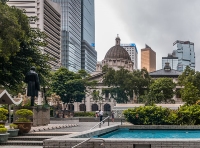
Statue Square is an amalgamation of Hong Kong's contemporary architecture. It reaches its most spectacular manifestation in the designs of the Hong Kong and Shanghai Banking Corporation and the Bank of China Tower. The most significant feature of the HSBC building is that it has been designed without a central core, a feat of structural engineering blended with the ultimate in aesthetic principles. There is also a statue of Sir Thomas Jackson outside the building. The Bank of China Tower became a much-debated conversation piece following its construction, largely because of the asymmetrically-designed pinnacle that acquires differing perspectives depending on one's vantage point. The square also contains the Cenotaph, a memorial to those who lost their lives in the two world wars.It is a popular gathering place for locals who meet to share meals and socialise; there is a fountain and seating areas. Over Winterfest there are usually Christmas displays, trees and lights put up in the square, although visitors have reported that the displays have become less impressive recently and other squares and malls have better Christmas arrangements. For those interested in architecture Statue Square is a treat, and the attraction is almost always included in walking tours of the city.
Transport : MTR Central station, exit K
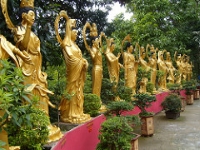
One of the most dramatic sacred sites in Hong Kong, the Ten Thousand Buddhas Monastery is perched at the top of a hill in the town of Sha Tin. Visitors must climb more than 400 stairs to reach the temple and the famous nine-storey pagoda. The monastery actually contains nearly 13,000 Buddha statues within its walls alone, and many more stand sentinel along the pathways and stairs. The statues come in a great variety of shapes and sizes and the temple complex is breathtakingly colourful with beautiful views. Sadly, there are no resident monks and the temple is managed by laypersons; you do not therefore feel as though you are visiting an active monastery. However, unlike many famous temples in Hong Kong, the Ten Thousand Buddhas Monastery has retained its tranquil atmosphere and still feels like a holy place. It is not commercialised and is seldom swamped by crowds. This is partly why it tends to make such an impression on tourists. There is a small restaurant selling simple refreshments at the top but it is advisable to bring your own water for the climb, which some find tiring. In some parts of the complex photography is not allowed - be sure to take note of the signs.
Address : 220 Pai Tau Village, Sha Tin
Transport : Take the East Rail line to Sha Tin.
Admission : Free entry
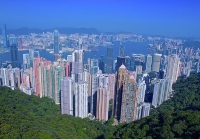
Victoria Peak is Hong Kong's number one tourist attraction and its popularity is unwavering. Much of the pleasure derived from a trip to Victoria Peak lies in the journey to its summit. The funicular railway or peak tram has steadily made its way up the mountain since 1888 and the route is extremely steep and rather thrilling, with spectacular views. Energetic travellers can scale the real peak that extends 140m (459ft) above the tram terminus. From the top, marvellous vistas open out onto central Hong Kong and across to Kowloon.Victoria Peak used to serve as a hill station in colonial times and later became the location of exclusive summer homes. Today it is a popular tourist spot offering a cooler vantage point from which to contemplate the pleasures of travel to the region. The Peak Tower on the summit houses numerous attractions, like a Ripley's Believe it or not 'Odditorium', shops and restaurants. The Sky Terrace offers a stunning 360-degree panoramic view across the Hong Kong skyline - probably the best view of the city you could find - and there is the added attraction of The Sky Gallery, which showcases the works of the city's talented artists. A lot of people choose to go up Victoria Peak at night when the city lights are at their most magical.
Website : www.thepeak.com.hk
Transport : Take the Peak Tram from Garden Road or bus 15C. There is also a shuttle bus (daily 9am to 7pm) that departs from Star Ferry Terminal.
Opening times : The Peak Tram runs every day, including Sundays and public holidays, between 7am and midnight. The tram departs every 10-15 minutes.
Admission : Tram fares for a round trip are HK$45 (adults), and HK$20 (children). There are other combined ticket deals available.
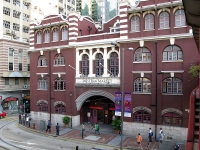
One of the best places to buy souvenirs in Hong Kong, this indoor market is held in a four-storey red brick colonial building that was constructed in 1906. After extensive renovation it re-opened in 1991 and now occupies an entire block at the western end of Central Hong Kong. The building houses a variety of shops and stalls that sell a range of products from jade curios and cloissan jewellery to assorted silks and fabrics. The fabric stores are particularly exciting and the second floor of the building is taken over by a veritable mountain of colourful fabrics of all kinds. There is a small restaurant on the first floor, and toilets on the fourth floor. However, if you aren't interested in shopping then this attraction will hold little appeal for you - if you are an architecture enthusiast you can pop in quickly to see the vaulted ceilings but there isn't much to see in the Western Market apart from the merchandise. Admiring the building from the outside will be sufficient for most, and it is often included in walking tours of the area. From the site one can hop onto Hong Kong's ancient double-decker tram headed for Wan Chai, Causeway Bay and Happy Valley.
Address : 323 De Voeux Road Central, Sheung Wang
Transport : Take the MTR to Sheung Wan, exit B or C; bus or tram along Des Voeux Road to Sheung Wan.
Opening times : Shops are open daily 10am to 7pm; restaurants 11am to 11pm.
Admission : Free
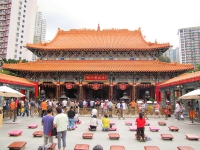
This grand Taoist temple is one of the most frequently visited temples in Hong Kong. It is dedicated to Wong Tai Sin, a legendary hermit who reputedly had healing powers and could foretell the future. A number of fortune tellers ply their trade in the temple complex and there is also a large pharmacy. There are some English-speaking fortune tellers (although they are more expensive) and they offer a number of soothsaying techniques including palm and face reading. The ornate temple with its red pillars, gold ceilings and decorative latticework is in the traditional Chinese style and is usually full of people burning incense and making floral offerings.The temple is known as a place where 'wishes come true' and locals come to pray for good health, success in business and happiness. Visitors can buy incense to burn just outside of the temple but there are usually lots of spare sticks left over from previous visitors within the temple itself so buying more may prove a waste of money. Those who do buy the incense need not purchase the whole kit as everything other than the sticks themselves will be taken by the guards at the entrace to the temple proper. The temple also has a lovely adjacent park called the 'Good Wish Gardens', a peaceful green spot with waterfalls tumbling over rocks.
Address : 2 Chuck Yuen Village, Kowloon
Transport : MTR to Wong Tai Sin, exit B
Opening times : Daily 7am to 5.30pm, gardens closed on Mondays.
Admission : Free (although donations are welcome)

Travel Guide powered by Word Travels, copyright © 2023 Globe Media Ltd. By its very nature information in this travel guide is subject to change at short notice and travellers are urged to verify information on which they're relying with the relevant authorities. Neither Globe Media Ltd nor Travel Vogue can accept any responsibility for any loss or inconvenience to any person as a result of information contained above.